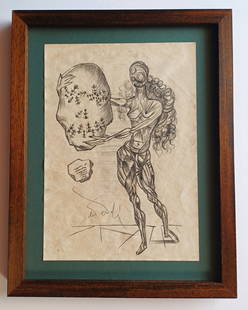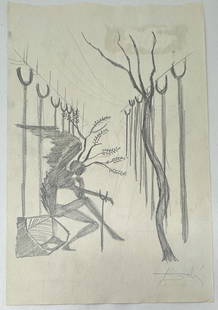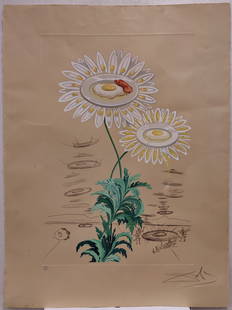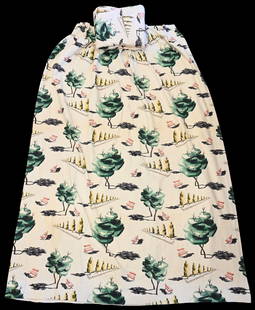
Salvador Dali (1904-1989) Signed Book with Drawing
Salvador Dalí Sale History
View Price Results for Salvador DalíRelated Drawings
More Items from Salvador Dalí
View MoreRecommended Art
View More









Item Details
Description
Salvador Dali (1904-1989) Original Drawing. The drawing is drawn by Dali on the front page of the book titled Dali, published by Abrams. The first page (opposite the title page) is inscribed by Dali - Pour Martin Riskin and includes a drawing by Dali of Don Quixote. The title page is also signed by Dali. The book was presented by Dali to his good friend Martin Riskin. For decades, Martin Riskin held the executive positions at The Plaza, The Pierre and The Waldorf-Astoria in New York City. Included with the drawing is a photo copy of the book cover - Life At The Top by Ward Morehouse III, and photo of Riskin with the artist Marc Chagall on page 99. Riskin is listed 6 times in the book index. Also included is a photo copy of Chagall celebrating his 90th birthday with friends. In the photograph, on the far right, is Chagall's friend Martin Riskin - the tall man on the far right wearing glasses and a black bow tie. The Dali book Measures 12.3 inches high, 11.4 inches wide. In good condition. From the estate of Martin Riskin.
From Ro Gallery: Salvador Dali was born in May 11, 1904 in the small agricultural town of Figueres, Spain, located in the foothills of the Pyrenees, only sixteen miles from the French border in the principality of Catalonia. The son of a prosperous notary, Salvador Dali spent his boyhood in Figueres and at the family's summer home in the coastal fishing village of Cadaques where his parents built his first studio. As an adult, he made his home with his wife Gala in nearby Port Lligat. Many of his paintings reflect his love of this area of Spain.
The young Salvador Dali attended the San Fernando Academy of Fine Arts in Madrid. Early recognition of Salvador Dali's talent came with his first one-man show in Barcelona in 1925. He became internationally known when three of his paintings, including The Basket of Bread (now in the Museum's collection), were shown in the third annual Carnegie International Exhibition in Pittsburgh in 1928. The following year, Dali held his first one-man show in Paris. He also joined the surrealists, led by former Dadaist Andre Breton. That year, Dali met Gala Eluard when she visited him in Cadaques with her husband, poet Paul Eluard. She became Dali's lover, muse, business manager, and chief inspiration.
Dali soon became a leader of the surrealist movement. His painting, The Persistence of Memory, with the soft or melting watches is still one of the best-known surrealist works. But as the war approached, the apolitical Dali clashed with the surrealists and was expelled from the surrealist group during a trial in 1934. He did however, exhibit works in international surrealist exhibitions throughout the decade but by 1940, Dali was moving into a new style that eventually became known as his classic period, demonstrating a preoccupation with science and religion.
Dali and Gala escaped from Europe during World War II, spending 1940-48 in the United States. These were very important years for the artist. The Museum of Modern Art in New York gave Dali his first major retrospective exhibit in 1941. This was followed in 1942 by the publication of Dali's autobiography, The Secret Life of Salvador Dali. As Dali moved away from Surrealism and into his classic period, he began his series of 19 large canvases, many concerning scientific, historical or religous themes. Among the best known of these works are The Hallucinogenic Toreador, and The Discovery of America by Christopher Columbus in the museum's collection, and The Sacrament of the Last Supper in the collection of the National Gallery in Washington, D.C. In 1974, Dali opened the Teatro Museo in Figueres, Spain. This was followed by retrospectives in Paris and London at the end of the decade.
After the death of his wife, Gala, in 1982, Dali's health began to fail. It deteriorated further after he was burned in a fire in his home in Pubol in 1984. Two years later, a pace-maker was implanted. Much of this part of his life was spent in seclusion, first in Pubol and later in his apartments at Torre Galatea, adjacent to the Teatro Museo. Salvador Dali died on January 23, 1989 in Figueres from heart failure with respiratory complications.
As an artist, Salvador Dali was not limited to a particular style or media. The body of his work, from early impressionist paintings through his transitional surrealist works, and into his classical period, reveals a constantly growing and evolving artist. Dali worked in all media, leaving behind a wealth of oils, watercolors, drawings, graphics, and sculptures, jewels and objects of all descriptions.
Whether working from pure inspiration or on a commissioned illustration, Dali's matchless insight and symbolic complexity are apparent. Above all, Dali was a superb draftsman. His excellence as a creative artist will always set a standard for the art of the twentieth century. Every morning when I wake up I experience an exquisite joy-the joy of being Salvador Dali - and I ask myself in rapture, What wonderful things this Salvador Dali is going to accomplish today? Salvador Dali.
From Ro Gallery: Salvador Dali was born in May 11, 1904 in the small agricultural town of Figueres, Spain, located in the foothills of the Pyrenees, only sixteen miles from the French border in the principality of Catalonia. The son of a prosperous notary, Salvador Dali spent his boyhood in Figueres and at the family's summer home in the coastal fishing village of Cadaques where his parents built his first studio. As an adult, he made his home with his wife Gala in nearby Port Lligat. Many of his paintings reflect his love of this area of Spain.
The young Salvador Dali attended the San Fernando Academy of Fine Arts in Madrid. Early recognition of Salvador Dali's talent came with his first one-man show in Barcelona in 1925. He became internationally known when three of his paintings, including The Basket of Bread (now in the Museum's collection), were shown in the third annual Carnegie International Exhibition in Pittsburgh in 1928. The following year, Dali held his first one-man show in Paris. He also joined the surrealists, led by former Dadaist Andre Breton. That year, Dali met Gala Eluard when she visited him in Cadaques with her husband, poet Paul Eluard. She became Dali's lover, muse, business manager, and chief inspiration.
Dali soon became a leader of the surrealist movement. His painting, The Persistence of Memory, with the soft or melting watches is still one of the best-known surrealist works. But as the war approached, the apolitical Dali clashed with the surrealists and was expelled from the surrealist group during a trial in 1934. He did however, exhibit works in international surrealist exhibitions throughout the decade but by 1940, Dali was moving into a new style that eventually became known as his classic period, demonstrating a preoccupation with science and religion.
Dali and Gala escaped from Europe during World War II, spending 1940-48 in the United States. These were very important years for the artist. The Museum of Modern Art in New York gave Dali his first major retrospective exhibit in 1941. This was followed in 1942 by the publication of Dali's autobiography, The Secret Life of Salvador Dali. As Dali moved away from Surrealism and into his classic period, he began his series of 19 large canvases, many concerning scientific, historical or religous themes. Among the best known of these works are The Hallucinogenic Toreador, and The Discovery of America by Christopher Columbus in the museum's collection, and The Sacrament of the Last Supper in the collection of the National Gallery in Washington, D.C. In 1974, Dali opened the Teatro Museo in Figueres, Spain. This was followed by retrospectives in Paris and London at the end of the decade.
After the death of his wife, Gala, in 1982, Dali's health began to fail. It deteriorated further after he was burned in a fire in his home in Pubol in 1984. Two years later, a pace-maker was implanted. Much of this part of his life was spent in seclusion, first in Pubol and later in his apartments at Torre Galatea, adjacent to the Teatro Museo. Salvador Dali died on January 23, 1989 in Figueres from heart failure with respiratory complications.
As an artist, Salvador Dali was not limited to a particular style or media. The body of his work, from early impressionist paintings through his transitional surrealist works, and into his classical period, reveals a constantly growing and evolving artist. Dali worked in all media, leaving behind a wealth of oils, watercolors, drawings, graphics, and sculptures, jewels and objects of all descriptions.
Whether working from pure inspiration or on a commissioned illustration, Dali's matchless insight and symbolic complexity are apparent. Above all, Dali was a superb draftsman. His excellence as a creative artist will always set a standard for the art of the twentieth century. Every morning when I wake up I experience an exquisite joy-the joy of being Salvador Dali - and I ask myself in rapture, What wonderful things this Salvador Dali is going to accomplish today? Salvador Dali.
Condition
Condition listed in the description
Buyer's Premium
- 22%
Salvador Dali (1904-1989) Signed Book with Drawing
Estimate $2,000 - $3,000
17 bidders are watching this item.
Shipping & Pickup Options
Item located in St. Petersburg, FL, usSee Policy for Shipping
Local Pickup Available
Payment

TOP















































![After Fernand LEGER: Portrait - Pencil Drawing: After Fernand Leger (French, 1881-1955) pencil on paper portrait of a seated woman with book, signed lower left, dated '25. [Art: 13" H x 9" W; Frame: 20" H x 16" W]. Foxing to paper.](https://p1.liveauctioneers.com/1221/326908/176009482_1_x.jpg?height=310&quality=70&version=1713991522)

![Gehry, Frank [SIGNED]; Chan Edwin; Webb Craig; Gehry Draws [1ST EDITION WITH DUST JACKET - FINE]: Cambridge, MA: MIT Press, 2004. Hardcover with pictorial dust jacket. First Edition. 4to - over 9¾" - 12" tall. 544 pages with more than 360 drawings and more than 400 additional illustrations](https://p1.liveauctioneers.com/8658/325945/175541866_1_x.jpg?height=310&quality=70&version=1712964944)

![Wood, Jonas; Hong Kong [SIGNED COPY WITH BASKETBALL DRAWING]: Gagosian, 2021. Hardcover in yellow paper boards. First Edition, First Printing. Unpaginated with circa 70 pages filled with color illustrations featuring flower images by Jonas Wood throughout. Text](https://p1.liveauctioneers.com/8658/325945/175541853_1_x.jpg?height=310&quality=70&version=1712964944)
![Ando, Tadao [SIGNED]; TADAO ANDO COMPLETE WORKS 1975-2012 [W/ ORIGINAL CHURCH OF LIGHT DRAWING]: Taschen, 2012. Hardcover in pictorial dust jacket. First Edition. 660 pages filled with images and text detailing the architectural ideas, philosophies and production of Tadao Ando between 1975 and 20](https://p1.liveauctioneers.com/8658/325945/175541704_1_x.jpg?height=310&quality=70&version=1712964944)
































